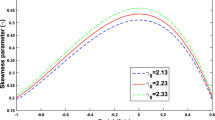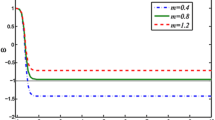Abstract
This work is devoted to the investigation of new holographic dark energy (infrared cutoff is the Hubble radius) in locally rotationally symmetric Bianchi type-\(I\) universe within the framework of Saez–Ballester (Phys. Lett. A 113:467, 1986) scalar–tensor theory of gravitation. We construct interacting and non-interacting dark energy models by solving the field equations using a relationship between the metric potentials. This leads to a variable deceleration parameter model which exhibits a transition of the universe from deceleration to acceleration. We evaluate various cosmological parameters of our models. We have observed that the energy density parameters, equation of state and important cosmological planes (\(\omega _{\mathit{de}} - \omega _{\mathit{de}}'\) and \(r - s\)) yield the results compatible with the modern observational data. We have, also, discussed the stability analysis of our models.









Similar content being viewed by others
References
Ade, P.A.R., et al. (Planks Collaboration): Astron. Astrophys. 571, A16 (2014)
Adhav, K.S.: Int. J. Astron. Astrophys. 1, 204 (2011)
Aditya, Y., Reddy, D.R.K.: Int. J. Geom. Methods Mod. Phys. 15, 1850156 (2018)
Amendola, L.: Phys. Rev. D 60, 043501 (1999)
Bamba, K., et al.: Astrophys. Space Sci. 341, 155 (2012)
Barati, F.: Int. J. Theor. Phys. 55, 2189 (2016)
Benerjee, N., Roy, N.: Gen. Relativ. Gravit. 47, 92 (2015)
Bento, M., et al.: Phys. Rev. D 66, 043507 (2002)
Bertolami, O., et al.: Phys. Lett. B 654, 165 (2007)
Bertolami, O., et al.: Gen. Relativ. Gravit. 41, 2839 (2009)
Bhaskar Rao, M.P.V.V., et al.: Can. J. Phys. (2017). https://doi.org/10.1139/cjp-2016-0670
Bisabr, Y.: Gen. Relativ. Gravit. 41, 305 (2009)
Brans, C., Dicke, R.H.: Phys. Rev. 124, 925 (1961)
Cai, R.G.: Phys. Lett. B 657, 228 (2007)
Caldwell, R.R.: Phys. Lett. B 545, 23 (2002)
Caldwell, R.R., Linder, E.V.: Phys. Rev. Lett. 95, 141301 (2005)
Capozziello, S., De Laurentis, M.: (2011). arXiv:1108.6266v2 [gr-qc]
Chen, S., Jing, J.: Phys. Lett. B 679, 144 (2009)
Clifton, T., et al.: Phys. Rep. 513, 1 (2012)
Cohen, A.G., et al.: Phys. Rev. Lett. 82, 4971 (1999)
Collins, C.B., et al.: Gen. Relativ. Gravit. 12, 805 (1980)
Copeland, E.J., et al.: Int. J. Mod. Phys. D 15, 1753 (2006)
Cruz, M., Lepe, S.: Class. Quantum Gravity 35, 155013 (2018)
Daly, R.A., et al.: Astrophys. J. 677, 1 (2008)
Deffayet, C.: Phys. Lett. B 502, 199 (2001)
Feng, B., et al.: Phys. Lett. B 607, 35 (2005)
Gao, C., et al.: Phys. Rev. D 79, 043511 (2009)
Granda, L., Oliveros, A.: Phys. Lett. B 669, 275 (2008)
Guo, Z.K., et al.: Phys. Rev. D 76, 023508 (2007)
Harko, T., et al.: Phys. Rev. D 84, 024020 (2011)
Hsu, S.D.H.: Phys. Lett. B 594, 13 (2004)
Hu, Y., et al.: J. Cosmol. Astropart. Phys. 08, 012 (2015)
Jawad, A., et al.: Commun. Theor. Phys. 63, 453 (2015)
Kamenshchik, A.Y., et al.: Phys. Lett. B 511, 265 (2001)
Khalatnikov, I.M., Kamenshchik, A.Y.: Phys. Lett. B 553, 119 (2003)
Komatsu, E., et al. (WMAP Collaboration): Astrophys. J. Suppl. Ser. 192, 18 (2011)
Li, M.: Phys. Lett. B 603, 1 (2004)
Li, M., et al.: J. Cosmol. Astropart. Phys. 09, 021 (2013)
Li, E.K., et al.: Gen. Relativ. Gravit. 47, 136 (2015)
Mazumder, N., Chakraborty, S.: Gen. Relativ. Gravit. 42, 813 (2010)
Medved, A.J.M.: Gen. Relativ. Gravit. 41, 287 (2009)
Mishra, B., et al.: Astrophys. Space Sci. 363, 86 (2018)
Mohammadi, A.K., Malekjani, M.: Gen. Relativ. Gravit. 44, 1163 (2012)
Nojiri, S., Odintsov, S.D.: Phys. Lett. B 562, 147 (2003a)
Nojiri, S., Odintsov, S.D.: Phys. Rev. D 68, 123512 (2003b)
Nojiri, S., Odintsov, S.D.: Gen. Relativ. Gravit. 38, 1285 (2006)
Nojiri, S., et al.: Phys. Rep. 692, 1 (2017)
Padmanabhan, T.: Phys. Rev. D 66, 02131 (2002)
Padmanabhan, T.: Gen. Relativ. Gravit. 40, 529 (2008)
Pavon, D., Zimdahl, W.: Phys. Lett. B 628, 206 (2005)
Perlmutter, S., et al.: Astrophys. J. 517, 5 (1999)
Pradhan, A., Singh, S.K.: Int. J. Mod. Phys. D 13, 503 (2004)
Praseetha, P., Mathew, T.K.: Class. Quantum Gravity 31, 185012 (2014)
Rao, V.U.M., Prasanthi, U.Y.D.: Eur. Phys. J. Plus 132, 64 (2017)
Rao, V.U.M., et al.: Results Phys. 10, 469 (2018)
Reddy, D.R.K.: Astrophys. Space Sci. 286, 365 (2003)
Reddy, D.R.K.: Can. J. Phys. 95, 145 (2017)
Reddy, D.R.K., et al.: Astrophys. Space Sci. 357, 20 (2015)
Reddy, D.R.K., et al.: Astrophys. Space Sci. 361, 349 (2016)
Riess, A.G., et al.: Astron. J. 116, 1009 (1998)
Sadri, E., Vakili, B.: Astrophys. Space Sci. 363, 13 (2018)
Saez, D., Ballester, V.J.: Phys. Lett. A 113, 467 (1986)
Saha, B.: Astrophys. Space Sci. 302, 83 (2006)
Sahni, V., Shtanov, Y.: J. Cosmol. Astropart. Phys. 11, 014 (2003)
Sahni, V., et al.: JETP Lett. 77, 201 (2003)
Salvatelli, V., et al.: Phys. Rev. D 88, 023531 (2013)
Santhi, M.V., et al.: Astrophys. Space Sci. 361, 142 (2016a)
Santhi, M.V., et al.: Prespacetime J. 7, 1939 (2016b)
Santhi, M.V., et al.: Int. J. Theor. Phys. 56, 362 (2017a)
Santhi, M.V., et al.: Can. J. Phys. 95, 179 (2017b)
Setare, M.R.: Phys. Lett. B 653, 116 (2007)
Setare, M.R., Jamil, M.: Gen. Relativ. Gravit. 43, 293 (2011)
Sharif, M., Jawad, A.: (2012). arXiv:1212.0129v1
Sharif, M., Khanum, F.: Gen. Relativ. Gravit. 43, 2885 (2011)
Sharif, M., et al.: Symmetry 10, 153 (2018)
Sheykhi, A., et al.: Int. J. Mod. Phys. D 25, 1650018 (2016)
Singh, C.P., Srivastava, M.: Eur. Phys. J. C 78, 190 (2018)
Singh, J.P., Tiwari, R.K.: Pramana 70, 565 (2008)
Spergel, D.N., et al.: Astrophys. J. Suppl. Ser. 148, 175 (2003)
Susskind, L.: J. Math. Phys. 36, 6377 (1995)
’t Hooft, G.: (1993). arXiv:gr-qc/9310026
Tegmark, M., et al.: Phys. Rev. D 69, 103501 (2004)
Wang, B., et al.: Phys. Lett. B 624, 141 (2005)
Acknowledgements
We thank the reviewer for their constructive comments which have certainly improved the presentation and quality of the paper.
Author information
Authors and Affiliations
Corresponding author
Rights and permissions
About this article
Cite this article
Aditya, Y., Reddy, D.R.K. Anisotropic new holographic dark energy model in Saez–Ballester theory of gravitation. Astrophys Space Sci 363, 207 (2018). https://doi.org/10.1007/s10509-018-3429-4
Received:
Accepted:
Published:
DOI: https://doi.org/10.1007/s10509-018-3429-4




